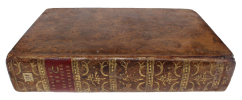"CUVIER, G.
Tableau élémentaire de l'Histoire Naturelle des Animaux. - [FOUNDATIONAL WORK OF MODERN ZOOLOGY AND COMPARATIVE ANATOMY]
Paris, Baudouin, An 6 (1798). 8vo. Nice cont. full mottled calf. Richly gilt back. Light wear to lower part of back and a small hole in leather at lower hinge. Red leather titlelabel. XVI,710 pp. and 14 engraved plates with many figs. A large clean copy.
Reference : 29881
First edition of Cuvier’s first work on comparative zoology, being one of the foundational texts of modern zoology and comparative anatomy. ""Cuvier’s Tableau élémentaire – his first separate work – contains the first general statement of his natural classification of the animal kingdom"" (Norman). The book thus constitutes the first systematic expression of a theory that would dominate zoological thought in the early nineteenth century. For later theorists, it provided the essential morphological basis for tracing evolutionary continuity between extinct and living species. Based on the course of lectures delivered at the École du Panthéon, Cuvier’s ”Tableau élémentaire presents for the first time his natural classification of the animal kingdom, establishing the four great divisions of the animal world: Vertebrata, Mollusca, Articulata and Radiata – according to anatomical structure, rather than superficial resemblance. It was from these studies of structural affinity between living forms that Cuvier developed the principles of comparative anatomy, which in turn laid the groundwork for palaeontology as a scientific discipline. Milestone of Science No. 44 Wood p. 307.
Bookseller's contact details
Herman H. J. Lynge & Son
William Schneider
Silkegade 11
1113 Copenhagen
Denmark
+45 33 155 335
Payment mode
Sale conditions
All items may be returned for a full refund for any reason within 14 days of receipt.
 Write to the booksellers
Write to the booksellers



